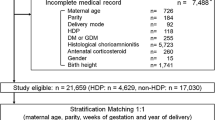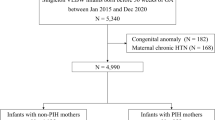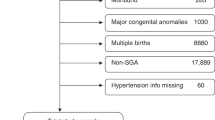Abstract
Objective:
To examine the relationship between hypertensive disorders of pregnancy (HDPs) and mortality and major morbidities in preterm neonates born at 24 to 28 weeks of gestation.
Study Design:
Using an international cohort, we retrospectively studied 27 846 preterm neonates born at 240 to 286 weeks of gestation during 2007 to 2010 from 6 national neonatal databases. The incidence of HDP was compared across countries, and multivariable logistic regression analyses were conducted to examine the association of HDP and neonatal outcomes including mortality to discharge, bronchopulmonary dysplasia, severe brain injury, necrotizing enterocolitis and treated retinopathy of prematurity.
Results:
The incidence of HDP in the entire cohort was 13% (range 11 to 16% across countries). HDP was associated with reduced odds of mortality (adjusted odds ratio (aOR) 0.77; 95% confidence interval (CI) 0.67 to 0.88), severe brain injury (aOR 0.74; 95% CI 0.62 to 0.89) and treated retinopathy (aOR 0.82; 95% CI 0.70 to 0.96), but increased odds of bronchopulmonary dysplasia (aOR 1.16; 95% CI 1.05 to 1.27).
Conclusions:
In comparison with neonates born to mothers without HDP, neonates of HDP mothers had lower odds of mortality, severe brain injury and treated retinopathy, but higher odds of bronchopulmonary dysplasia. The impact of maternal HDP on newborn outcomes was inconsistent across outcomes and among countries; therefore, further international collaboration to standardize terminology, case definition and data capture is warranted.
This is a preview of subscription content, access via your institution
Access options
Subscribe to this journal
Receive 12 print issues and online access
$259.00 per year
only $21.58 per issue
Buy this article
- Purchase on Springer Link
- Instant access to full article PDF
Prices may be subject to local taxes which are calculated during checkout


Similar content being viewed by others
References
Hauth JC, Ewell MG, Levine RJ, Esterlitz JR, Sibai B, Curet LB et al. Pregnancy outcomes in healthy nulliparas who developed hypertension. Calcium for preeclampsia prevention study group. Obstet Gynecol 2000; 95 (1): 24–28.
Report of the National High Blood Pressure Education Program Working Group on High Blood Pressure in Pregnancy. Am J Obstet Gynecol 2000; 183 (1): S1–S22.
Hutcheon JA, Lisonkova S, Joseph KS . Epidemiology of pre-eclampsia and the other hypertensive disorders of pregnancy. Best Pract Res Clin Obstet Gynaecol 2011; 25 (4): 391–403.
Xiong X, Mayes D, Demianczuk N, Olson DM, Davidge ST, Newburn-Cook C et al. Impact of pregnancy-induced hypertension on fetal growth. Am J Obstet Gynecol 1999; 180 (1 Pt 1): 207–213.
Backes CH, Markham K, Moorehead P, Cordero L, Nankervis CA, Giannone PJ . Maternal preeclampsia and neonatal outcomes. J Pregnancy 2011; 2011: 214365.
Allen VM, Joseph K, Murphy KE, Magee LA, Ohlsson A . The effect of hypertensive disorders in pregnancy on small for gestational age and stillbirth: a population based study. BMC Pregnancy Childbirth 2004; 4 (1): 17.
Roberts CL, Algert CS, Morris JM, Ford JB, Henderson-Smart DJ . Hypertensive disorders in pregnancy: a population-based study. Med J Aust 2005; 182 (7): 332–335.
Chen XK, Wen SW, Smith G, Yang Q, Walker M . Pregnancy-induced hypertension and infant mortality: roles of birthweight centiles and gestational age. BJOG 2007; 114 (1): 24–31.
Fortes Filho JB, Costa MC, Eckert GU, Santos PG, Silveira RC, Procianoy RS . Maternal preeclampsia protects preterm infants against severe retinopathy of prematurity. J Pediatr 2011; 158 (3): 372–376.
Yu XD, Branch DW, Karumanchi SA, Zhang J . Preeclampsia and retinopathy of prematurity in preterm births. Pediatrics 2012; 130 (1): e101–e107.
Perlman JM, Risser RC, Gee JB . Pregnancy-induced hypertension and reduced intraventricular hemorrhage in preterm infants. Pediatr Neurol 1997; 17 (1): 29–33.
Thornton C, Hennessy A, von DP, Nishi C, Makris A, Ogle R . An international benchmarking collaboration: measuring outcomes for the hypertensive disorders of pregnancy. J Obstet Gynaecol Can 2007; 29 (10): 794–800.
Shah PS, Lee SK, Lui K, Sjors G, Mori R, Reichman B et al. The International Network for Evaluating Outcomes of very low birth weight, very preterm neonates (iNeo): a protocol for collaborative comparisons of international health services for quality improvement in neonatal care. BMC Pediatr 2014; 14: 110.
Lowe SA, Brown MA, Dekker GA, Gatt S, McLintock CK, McMahon LP et al. Guidelines for the management of hypertensive disorders of pregnancy 2008. Aust N Z J Obstet Gynaecol 2009; 49 (3): 242–246.
Magee LA, Pels A, Helewa M, Rey E, von DP . Diagnosis, evaluation, and management of the hypertensive disorders of pregnancy: executive summary. J Obstet Gynaecol Can 2014; 36 (5): 416–441.
Riskin A, Riskin-Mashiah S, Lusky A, Reichman B . The relationship between delivery mode and mortality in very low birthweight singleton vertex-presenting infants. BJOG 2004; 111 (12): 1365–1371.
Watanabe K, Naruse K, Tanaka K, Metoki H, Suzuki Y . Outline of definition and classification of "Pregnancy induced Hypertension (PIH)". Hypertens Res Pregnancy 2013; 1: 3–4.
WHO. International statistical classification of diseases and related health problems 10th revision (ICD-10)-2015-WHO Version for 2015; 2015. Available from World Health Organization.
National Collaborating Centre for Women's and Children's Health (UK) Hypertension in Pregnancy: The Management of Hypertensive Disorders during Pregnancy. RCOG Press: London, 2010.
Shennan AT, Dunn MS, Ohlsson A, Lennox K, Hoskins EM . Abnormal pulmonary outcomes in premature infants: prediction from oxygen requirement in the neonatal period. Pediatrics 1988; 82 (4): 527–532.
Papile LA, Burstein J, Burstein R, Koffler H . Incidence and evolution of subependymal and intraventricular hemorrhage: a study of infants with birth weights less than 1,500 gm. J Pediatr 1978; 92 (4): 529–534.
International Committee for the Classification of Retinopathy of Prematurity. The international classification of retinopathy of prematurity revisited. Arch Ophthalmol 2005; 123 (7): 991–999.
Bell MJ, Ternberg JL, Feigin RD, Keating JP, Marshall R, Barton L et al. Neonatal necrotizing enterocolitis. Therapeutic decisions based upon clinical staging. Ann Surg 1978; 187 (1): 1–7.
Zhang J, Meikle S, Trumble A . Severe maternal morbidity associated with hypertensive disorders in pregnancy in the United States. Hypertens Pregnancy 2003; 22 (2): 203–212.
von DP, Magee LA, Taylor EL, Muir JC, Stewart SD, Sherman P et al. Maternal hypertension and neonatal outcome among small for gestational age infants. Obstet Gynecol 2005; 106 (2): 335–339.
Rey E, Couturier A . The prognosis of pregnancy in women with chronic hypertension. Am J Obstet Gynecol 1994; 171 (2): 410–416.
Finucane MM, Stevens GA, Cowan MJ, Danaei G, Lin JK, Paciorek CJ et al. National, regional, and global trends in body-mass index since 1980: systematic analysis of health examination surveys and epidemiological studies with 960 country-years and 9.1 million participants. Lancet 2011; 377 (9765): 557–567.
Kenny LC, Lavender T, McNamee R, O'Neill SM, Mills T, Khashan AS . Advanced maternal age and adverse pregnancy outcome: evidence from a large contemporary cohort. PLoS One 2013; 8 (2): e56583.
Conde-Agudelo A, Althabe F, Belizan JM, Kafury-Goeta AC . Cigarette smoking during pregnancy and risk of preeclampsia: a systematic review. Am J Obstet Gynecol 1999; 181 (4): 1026–1035.
Klemmensen A, Olsen S, Osterdal M, Tabor A . Validity of preclampsia-related diagnoses recorded in a national hospital registry and in a postpartum interview of the women. Am J Epidemiol 2007; 166 (2): 117–124.
Regev RH, Arnon S, Litmanovitz I, Bauer-Rusek S, Boyko V, Lerner-Geva L et al. Outcome of singleton preterm small for gestational age infants born to mothers with pregnancy-induced hypertension. A population-based study. J Matern Fetal Neonatal Med 2015; 28 (6): 666–673.
Cole SR, Platt RW, Schisterman EF, Chu H, Westreich D, Richardson D et al. Illustrating bias due to conditioning on a collider. Int J Epidemiol 2010; 39 (2): 417–420.
Wilcox AJ . On the importance—-and the unimportance—-of birthweight. Int J Epidemiol 2001; 30 (6): 1233–1241.
Wang A, Holston AM, Yu KF, Zhang J, Toporsian M, Karumanchi SA et al. Circulating anti-angiogenic factors during hypertensive pregnancy and increased risk of respiratory distress syndrome in preterm neonates. J Matern Fetal Neonatal Med 2012; 25 (8): 1447–1452.
Gortner L, Misselwitz B, Milligan D, Zeitlin J, Kollee L, Boerch K et al. Rates of bronchopulmonary dysplasia in very preterm neonates in Europe: results from the MOSAIC cohort. Neonatology 2011; 99 (2): 112–117.
Hansen AR, Barnes CM, Folkman J, McElrath TF . Maternal preeclampsia predicts the development of bronchopulmonary dysplasia. J Pediatr 2010; 156 (4): 532–536.
Haig D . Genetic conflicts in human pregnancy. Q Rev Biol 1993; 68 (4): 495–532.
Wilson-Costello D, Friedman H, Minich N, Siner B, Taylor G, Schluchter M et al. Improved neurodevelopmental outcomes for extremely low birth weight infants in 2000-2002. Pediatrics 2007; 119 (1): 37–45.
Shankaran S, Bauer CR, Bain R, Wright LL, Zachary J . Relationship between antenatal steroid administration and grades III and IV intracranial hemorrhage in low birth weight infants. The NICHD Neonatal Research Network. Am J Obstet Gynecol 1995; 173 (1): 305–312.
Petrova A, Mehta R . Magnesium sulfate tocolysis and intraventricular hemorrhage in very preterm infants. Indian J Pediatr 2012; 79 (1): 43–47.
Bain E, Middleton P, Crowther CA . Different magnesium sulphate regimens for neuroprotection of the fetus for women at risk of preterm birth. Cochrane Database Syst Rev 2012; 2: CD009302.
Raio L, Bolla D, Baumann M . Hypertension in pregnancy. Curr Opin Cardiol 2015; 30 (4): 411–415.
Adu-Bonsaffoh K . [234-POS]: Proposed modification to classification of hypertensive disorders in pregnancy. Pregnancy Hypertens 2015; 5 (1): 118.
Tranquilli A, Brown M, Zeeman G, Dekker G, Sibai B . The definition of severe and early-onset preeclampsia. Statments from the International Society for the Study of Hypertension in Pregnancy (ISSHP). Pregnancy Hypertens 2013; 3 (1): 44–47.
Thornton C, Hennessy A, Grobman WA . Benchmarking and patient safety in hypertensive disorders of pregnancy. Best Pract Res Clin Obstet Gynaecol 2011; 25 (4): 509–521.
Acknowledgements
The Maternal-Infant Care Research Centre is supported by a team grant (FRN87518) from the Canadian Institutes of Health Research and Mount Sinai Hospital, Toronto, ON, Canada. We thank all site investigators in six countries for their support and diligent data collection. Prakesh Shah is supported by an Applied Research Chair in Reproductive and Child Health Services and Policy Research from the Canadian Institutes of Health Research (APR-126340). A list of contributing neonatal units and their investigator names are included in the Supplementary Information. Funding for iNeo has been provided by a Canadian Institutes of Health Research Chair in Reproductive and Child Health Services and Policy Research held by PSS. The Canadian Neonatal Network is funded by financial support from the Canadian Institutes of Health Research and individual participating centers. The Australian and New Zealand Neonatal Network is predominantly funded by membership contributions from participating centers. The Israel Neonatal Network very low birth weight infant database is partially funded by the Israel Center for Disease Control and the Ministry of Health. The Neonatal Research Network of Japan is partly funded by a Health Labour Sciences Research Grant from the Ministry of Health, Labour and Welfare of Japan. The Swedish Neonatal Quality Register is funded by the Swedish Government (Ministry of Health and Social Affairs) and the body of regional health care providers (County Councils). The United Kingdom Neonatal Collaborative receives no core funding.
Author information
Authors and Affiliations
Consortia
Corresponding author
Ethics declarations
Competing interests
The authors declare no conflict of interest.
Additional information
Supplementary Information accompanies the paper on the Journal of Perinatology website
Supplementary information
Rights and permissions
About this article
Cite this article
Gemmell, L., Martin, L., Murphy, K. et al. Hypertensive disorders of pregnancy and outcomes of preterm infants of 24 to 28 weeks’ gestation. J Perinatol 36, 1067–1072 (2016). https://doi.org/10.1038/jp.2016.133
Received:
Revised:
Accepted:
Published:
Issue Date:
DOI: https://doi.org/10.1038/jp.2016.133
This article is cited by
-
Outcomes of singleton preterm very low birth weight infants born to mothers with pregnancy-induced hypertension
Scientific Reports (2023)
-
Maternal hypertensive disorders and survival without major morbidities among extremely low gestation newborns
Journal of Perinatology (2023)
-
Association of maternal hypertension during pregnancy with brain structure and behavioral problems in early adolescence
European Child & Adolescent Psychiatry (2023)
-
Neonatal outcomes of twins <29 weeks gestation of mothers with hypertensive disorders of pregnancy
Pediatric Research (2022)
-
Population-based study on birth outcomes among women with hypertensive disorders of pregnancy and gestational diabetes mellitus
Scientific Reports (2021)



